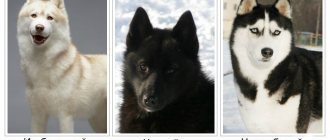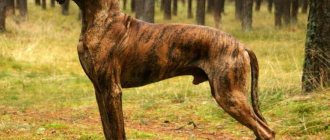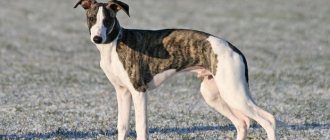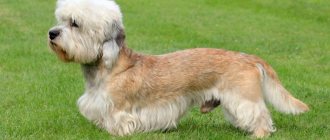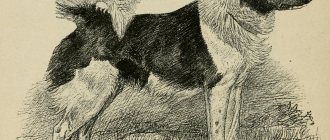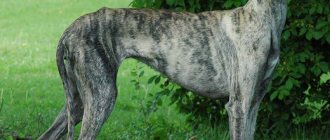Story
The first mentions of the Mongol-Buryat wolfhound are associated with tribes roaming the territory of Buryatia. Dogs served as guards and hunters. There is a version: the dogs were at Buddhist monasteries.
Dog breeders are still arguing about the origin of the breed. Many archaeologists are sure that the Khotosho Nokhoi are descendants of the oldest breed group.
Buddhists regard wolfhounds as divine creatures. Despite their impressive size, dogs were always included in the house and became the main characters of legends. One of them says: the ancestor Sarama is the right hand of God Indra, black and brown in color. The Buryat-Mongolian wolfhound is famous for this same shade, which means it is sacred. There is another belief about a black dog with reddish spots on its forehead. She put in a word in front of the angry Buddha, asking him to leave grains in the fields, and saved people from hunger and death.
At the end of the 19th century, the number of wolfhounds in Buryatia decreased by 50%. Mass breeding of dogs began. Nikolai Batov took up the task of restoring the wolfhound population.
The breed was officially registered by the Canine Society in 2000.
The dog is called:
- I want to nohoy,
- Mongolian Shepherd,
- bakharom,
- wolfhound,
- Tibet
- Mongolian mastiff,
- yard wolf.
These are not all the popular names of the animal. There are over 10 of them.
Advantages and disadvantages
Good-natured Buryat-Mongolian wolfhounds are only so formidable and terrifying in appearance. When you get to know each other better, you will find out how affectionate and loyal they are. It’s not scary to leave a small child with them, and when he grows up, he can easily control his big four-legged friend.
At any age, people are happy to respond to an offer to play. They are agile and dexterous, which is something you can’t tell right away. Even towards other dogs they do not bully, but try to involve them in the game. True, sometimes in a rather strange way.
These dogs are easy to care for and not picky about food and living conditions. Choosing one leader for themselves, they nevertheless faithfully and obediently serve everyone who belongs to the master’s family. Buryats are very easy to raise and teach all the necessary commands.
True, sometimes you can stumble upon stubbornness and laziness. Over many centuries, these dogs have become accustomed to being close to humans and being his reliable friend and bodyguard.
Description
Cynologists call Mongolian wolfhounds unique individuals. The reason is the abundance of features in the dog that are alien to other breeds.
The main qualities of a wolfhound:
- independence;
- devotion to the owner, family;
- sociability;
- friendliness;
- playfulness;
- learning ability;
- protection;
- ability to swim well.
The Buryat is able to adapt to any situation and the different moods of the owner. A calm environment around is important for the dog.
| Body part | Peculiarities |
| Head | Beautifully shaped, with strong skull and cheekbones |
| Neck | Strong. Equal in proportions to the muzzle |
| Rib cage | Wide, round |
| Lips | Full |
| Nose | Big, black |
| Teeth | Densely arranged, large, white. Scissor bite |
| Eyes | Oval, medium. Shade from amber to brown |
| Back | Wide, with well-developed muscles |
| Ears | Medium in size, triangular in shape. In a calm mood they hang, in a wary mood they rise |
| Leather | Dense, elastic |
| Paws | Straight, strong, neat |
| Tail | In a balanced state, lowered. Rising with emotional outburst |
| Wool | Dense, rough. The undercoat is thick and soft |
Description of the breed
The Buryat-Mongolian wolfhound at first seems massive and squat, but at the same time representatives of this species have a proportional body.
Table. Breed standards for Buryat-Mongolian wolfhound
| Body part, other indicators | Standard |
| Weight, height at withers (kg/cm) | 70/75 |
| Wool | Has hard guard hair. Dogs are long-haired, semi-long-haired, short-haired. |
| Eyes | Oval, small, brown in different shades - from amber to dark. |
| Head | Large in size, with a slightly convex and wide skull. The muzzle appears somewhat short. There are two types of dogs: long-headed and wide-faced. |
| Ears | In the shape of a triangle, located high, hanging on cartilages |
| Nose | Straight, large, dark lobe |
| Frame | Stretched, tightly knit, with a deep chest and prominent ribs. The croup is slightly sloping. The back is wide, strong, straight. The lumbar area is not elongated. |
| Limbs | Muscular, with strong bones. The paws are voluminous, the toes are pressed together |
| Tail | Long, hanging, reaches the hock joint of the hind leg, looks heavy. When the dog is excited, the tail rises in a crescent shape, creating a ring over the back or resting lightly on it. |
Wolfhounds on vacation
Video - Description of the Khotosho breed
Accepted colors
The standards allow three colors:
- black;
- ginger;
- black and tan.
Less desirable colors are agouti and spotted.
Khotosho red and tan
Behavior and skills
The Buryat dog breed is distinguished by its balance. Dogs do not attack without a reason; they quickly think through every action. Dogs show aggression when they really cannot do without it, protecting their owner. Wolfhounds often save unfamiliar children from harm.
Mongolian Shepherds are attentive to every assignment and carry out commands of any complexity. Dogs benefit from a high level of intelligence.
There are also disadvantages in the behavior of wolfhounds. Dogs are subject to frequent mood swings. This negatively affects the dog’s sociability, obedience, and desire to follow commands.
Wolfhounds are distinguished by their strong-willed disposition. Dogs build relationships with people as cooperation. They do not accept unquestioning submission.
Expert opinion
Anna Abramenko
An avid dog lover. Experience in veterinary medicine since 2009.
Ask a Question
The wolfhound is easy to train. A properly raised dog demonstrates important skills from childhood. The dog is clean, while locked up, will not allow himself to relieve himself in the house, and will show patience.
A wolfhound can be the best nanny. The dog will look after the children in the yard and bring them back from their walks in a timely manner.
The dog does not ignore calls for help. Having noticed a drowning person, the wolfhound will begin to bark, draw attention to the incident, rush into the water, and save the victim.
The breed is also a godsend for unhealthy people. Buryat-Mongols are ready to bring the necessary thing, warm the owner with their bodies, and after training, become guides for the visually impaired.
History of the Buryat-Mongolian Wolfhound breed
Excavations carried out in remote areas of Buryatia - on the site of the so-called Hun settlement - made it possible to collect priceless artifacts confirming the exceptional antiquity of the Buryat-Mongolian wolfhound breed.
This breed is most likely older than the Tibetan mastiffs, which are considered the ancestors of most modern dog breeds.
The habitat of these majestic animals extends over tens of thousands of square kilometers, affecting the territories of Buryatia, Ust-Orda Okrug, Aginsky Buryat Okrug, Irkutsk Region, Tuva, Northern China, Mongolia, Tibet, and Kazakhstan.
The Buryat-Mongolian wolfhound dog has been considered sacred by many Asian peoples since ancient times.
Photo 1. Buryat-Mongolian wolfhounds are massive and majestic animals
There were legends about it, it served as a ritual symbol in many ancient cultures.
The original purpose of the Buryat-Mongolian wolfhounds is to protect livestock (sheep, camels), as well as the homes of the ancient Mongols, Buryats, Tibetans, aimags from external enemies (people and wild animals), and also to help people in hunting.
These qualities of wolfhounds are still in demand today by security agencies, law enforcement agencies and intelligence agencies.
The lack of targeted breeding work led to the almost complete disappearance of the breed by the end of the 1980s.
The revival of the Buryat-Mongolian wolfhounds became possible thanks to the efforts of two enthusiasts of their work - Marika Teregulova, who now heads the Baikal Cynological Federation, and Nikolai Batov, the head of one of the kennel clubs of Buryatia.
It was they who organized scientific expeditions to remote areas of Buryatia and Mongolia in order to find surviving purebred representatives of the ancient breed of Buryat-Mongolian wolfhound, as well as historical evidence, legends and tales associated with these dogs.
They, in the Buryat village of Verkhnyaya Ivolga and in the capital center of Buryatia, Ulan-Ude, founded nurseries for breeding these wonderful animals, and also developed the first breed standard.
Today, Buryat-Mongolian wolfhounds are no longer in danger of extinction, although the breed is still considered rare and requires intensive breeding work.
“Buryat-Mongolian Wolfhound” is the official name of the breed. Sometimes representatives of these dogs can be simply called wolfhound, Tibetan dog, Mongolian shepherd dog, hotosho, bankhar, dog of the Huns (Hun dog).
These terms have deep historical roots, they are equivalent in meaning, and their use depends on the region of residence of the dog.
Character and appearance
Dogs are often called yard wolves. Wolfhounds are confident, decisive, and strongly attached to home. There are dogs from foreign and native territory. The dog will never start a conflict. If there are several animals, he will not offend the weak or provoke his own kind.
The wolfhound respects those around him, but will not tolerate shouting or rude actions. The dog will not respond to cruelty with aggression, but will achieve its goal by completely ignoring the owner. If household members are fair to the animal, then there will be no problems.
The only people to whom the wolfhound will not show character are children. The dog will tolerate pampering and attempts to ride him. Having noticed a child playing deep in the river or sea, the dog will push him to the shore.
The Mongol-Buryat wolfhound is one of the most massive dogs of our time. Males reach 75 cm. The height of females is 65 cm. The average weight of a mature individual is 75 kg.
The dog's body and head are large, the muzzle does not look bulky. Oval eyes of brown color (there are yellowish-amber shades). The dog's chest is deep-set. The dog has strong, sinewy legs. The wolfhound's muscles are hidden by fur. Among representatives of the breed, it is long or short, but always thick, repelling moisture. Hotosho come in black, tan, and reddish colors.
Expert opinion
Anna Abramenko
An avid dog lover. Experience in veterinary medicine since 2009.
Ask a Question
In summer, dogs shed, and by winter a dense undercoat appears. The dog survives any season comfortably.
Breed standard Buryat-Mongolian wolfhound
For the first time, data on Buryat-Mongolian wolfhounds was included in the Russian stud book in 2000.
At the same time, under the auspices of the Russian Canine Federation, brands and pedigrees for this dog breed were developed.
The first breed standard for the Buryat-Mongolian Wolfhound (Khotosho) was published in 2006.
According to the standard, Buryat-Mongolian wolfhounds are considered large dogs with well-developed muscles. Males are noticeably larger than females.
The height at the withers for males should not be lower than 74 cm, for females - 66 cm.
Wolfhounds are characterized by long maturation, which in some individuals can last up to six years.
Photo 2. Buryat-Mongolian wolfhounds are smart and vigilant
The norm is a balanced type of behavior, which gives way to active and sharply aggressive behavior towards the offender in critical situations.
The hair of Buryat-Mongolian wolfhounds is coarse, with a thick soft undercoat.
It is customary to distinguish between long-haired (up to 30 cm), medium-haired (about 10 cm) and short-haired (less than 5 cm) Buryat-Mongolian wolfhounds.
Regardless of the length of their coat, all wolfhounds shed intensively in the summer.
Wolfhounds are characterized by a black and tan coloration with a small white spot on the chest.
As variations, brown, black, gray and red colors of different shades are acceptable.
The head is large, proportional, with prominent cheekbones.
The ears are triangular in shape and medium in size.
Eyes can vary in color (dark brown, amber) and should be oval in shape. Blue eye color is considered a disqualifying defect.
The teeth should be white, tightly adjacent to each other, and located in one line. Scissor bite.
The tail in a calm state is usually lowered down; it is allowed to throw it when moving on the back.
The paws of Buryat-Mongolian wolfhounds are powerful, large, with pronounced muscles.
Purebred hotosho are leisurely and free in their movements.
Breeding
The roots of the breed go back to ancient times, but the wolfhound cannot be called a common species. Such dogs are often found in Buryatia, Tibet, and in the cities of Central Asia.
The breed is bred by private dog breeders and nursery specialists. To develop the livestock, healthy individuals with the best physical and psychological characteristics are recruited.
Expert opinion
Anna Abramenko
An avid dog lover. Experience in veterinary medicine since 2009.
Ask a Question
The first dogs that come across will not make a couple. Domestic wolves are selective in choosing a partner. It will take time to get to know each other and develop sympathy in dogs.
History of the breed
The Buryat-Mongolian wolfhound is a beautiful and large dog.
The first mentions of dogs of this breed are associated with the tribes that roamed Buryatia. The dogs were guards and helped people in hunting. There is also a version that such animals lived in Buddhist monasteries. However, disputes about the origin of the breed have not subsided to this day.
Buddhists consider wolfhounds to be almost divine animals. Dogs of this breed are distinguished by their large size, but since ancient times they have been included in homes, and various legends have been written about them.
Khotosho are a very ancient breed, it is possible that they are older than even Tibetan mastiffs. However, by the end of the last century, these animals practically disappeared. In order to revive the breed, cynologist Nikolai Batov organized various expeditions in which he tried to fully recognize and restore the standards and appearance of wolfhounds.
He also collected various legends and tales about animals. As a result, by 2000 a special breed standard was developed. In the same year, on April 18, the Khotosho or Buryat-Mongolian wolfhound was registered as a separate species, but only by the Russian Canine Federation.
For reference! The international community and kennel clubs do not yet recognize these dogs.
Education and training
Wolfhounds can be trained from 2 months of age. Dogs are already receptive to commands and understand what is expected of them. When it comes to raising and training a dog, it is important to adhere to humane methods. Otherwise, a frightened, cowardly dog will grow up.
It is worth starting the training process for a wolfhound with basic tasks, gradually complicating them.
Teams:
- "Near". The ability to accompany the owner is an important skill. Having found it, walking with your dog will turn into pleasure. The pet will walk close to the person’s leg and run away only after receiving permission. When saying the word “near”, you need to jerk the leash. When the dog tries to run away from the owner, the manipulation must be repeated.
- “Fu” is pronounced in a firm tone. The puppy should feel the person’s irritation.
- "Sit". With such a command, they place their palm close to the dog’s muzzle.
- "Lie". First, after indicating the request, you will have to guide your four-legged friend and help him lie down. Over time, the dog must cope with the goal on its own.
- "To me". If the puppy immediately runs after hearing the task, he should be rewarded with a treat.
- "Aport." One of the favorite teams of pets, accepted for the game.
Every correct action of a four-legged animal should be encouraged. You can't skimp on praise. It is important for the dog to feel that the owner is happy and sees progress in the animal’s actions.
There is no need to delay the training process. If the dog gets tired, then next time he will be reluctant to make contact.
Education and training BMW
When a puppy first appears in the house, it is necessary to familiarize the pet with its future household. The dog has innate protective instincts, so he will protect his owner’s home, his family and other animals from early childhood
However, the owner needs to be shown that, despite the independence and importance of the dog, the person in charge in the house is the person
When parenting, you need to be persistent and patient. The dog takes training well, but is prone to laziness and stubbornness. In order to establish contact with a four-legged animal, you need to talk to it and calmly explain what is required of it.
It is impossible to force a Buryat wolfhound to learn by shouting and brute force. In this case, the dog will stop obeying and begin to ignore the teacher. Treats and praise should be used as incentives. If the dog is stubborn, you need to distract him with a game and start practicing commands later.
City dogs are recommended to take a special obedience course from a specialist. Training will speed up the socialization of the animal and make the pet a good companion. BMWs do not need to be taught security skills, since they are genetically embedded in them.
Care and maintenance of the Buryat-Mongolian wolfhound
Dogs are not whimsical. Keeping wolfhounds at home or in the yard is not a labor-intensive task.
If a Buryat-Mongolian dog lives on the street, then it is necessary to provide a spacious booth or enclosure. It is important that there is no draft and that there is shade.
What should a pet owner do:
- Comb, cut out tangles.
- Trim nails monthly.
- Check paw pads after every walk. If cuts are found, treat promptly.
- Rinse the dog's eyes with the broth.
- Brush your teeth with a special paste.
- Follow the vaccination schedule. Vaccinations starting at 1 month of age.
- Bathe your furry friend as soon as he gets dirty. The dog is capable of self-cleaning. It is enough to arrange water treatments 2-3 times a year in the summer. Any dog shampoo will do.
Care and maintenance
Once a year, before the beginning of summer, hotoshos with any type of coat experience a very heavy shedding. The wool literally peels off of them in layers. Daily combing and plucking of the hair by hand (manual trimming) will help to give the dog the proper appearance during this period.
By shedding his warm fur coat, the dog can withstand the heat much easier and immediately becomes slimmer. The rest of the time, weekly brushing is sufficient. And it is imperative to use products that will prevent the appearance of various skin parasites.
Such a dog is bathed once or twice a year. Khotosho will happily enjoy this procedure in natural bodies of water, as they are excellent swimmers. Special attention should be paid to your dog's floppy ears, which need to be cleaned regularly.
Although Mongolians can get along in an apartment, it is still recommended to bring them into private homes with their own yard. This way the dog will feel much freer and more comfortable. You should not chain your hotshot; there are other breeds that are better suited for this. Instead, give your pet an enclosure with a canopy and a spacious kennel.
The final physical growth of a Mongolian ceases only around the age of four. For normal muscle development throughout the entire formation period, the dog requires sufficient physical activity.
Nutrition
Wolfhounds are not capricious, but it is important to be careful about feeding. Food should be balanced and healthy. The dog will need additional vitamins.
The main products for maintaining the tone and strength of the breed:
- lean meat;
- heart, liver;
- boiled cereals;
- cottage cheese, kefir, fermented baked milk;
- seafood;
- chicken, quail eggs;
- vitamin preparations.
Representatives of the breed love to eat; allergic reactions to food do not occur.
In the first 3 months, puppies eat up to 6 times a day. From six months - three times. From 12 months eat twice a day.
Expert opinion
Anna Abramenko
An avid dog lover. Experience in veterinary medicine since 2009.
Ask a Question
Breeders of the breed recommend dry food. Cheap options for dogs are not suitable. The health and well-being of your pet depends on food.
It is recommended to feed the animal 2 hours before or after activity.
Maintenance and care
Khotosho are unpretentious in care. However, this does not exempt owners from complying with basic rules for keeping pets. When a wolfhound lives on the street, he needs a spacious booth or enclosure. The place of residence will need to be cleaned and washed regularly. Drafts are contraindicated for dogs, so the booth is covered with a durable coating. Owners should also remember the following responsibilities:
- regularly cut out tangles;
- trim your nails in a timely manner;
- After each walk, watch your paw pads. If cuts form on them, promptly carry out disinfection measures;
- periodically wash dogs' eyes with herbal decoctions;
- brush your teeth with a special toothpaste for dogs;
- According to the standard, all necessary vaccinations are given when the puppy reaches 1 month;
- bathe your pet periodically. Wolfhounds are capable of self-cleaning, but it is advisable for owners to bathe them themselves 3-4 times a year. For water procedures, any dog shampoo can be used.
As for nutrition, it is worth sticking to a balanced diet from an early age. Only proper nutrition guarantees that the dog will grow up strong, fit and healthy. Adults are fed 2-3 times a day. And small puppies are given food 5-6 times a day. The menu uses dry store food or naturally prepared food. If owners purchase ready-made food, then it is advisable to focus on high-quality products that do not contain preservatives and corn.
When feeding naturally, remember: the basis of a dog’s diet is meat. Rice, buckwheat, offal, and low-fat fish are used as auxiliary products. Add mineral supplements to your pet's diet several times a year. They will help replenish the lack of vitamins in the body. Owners are prohibited from introducing chocolate, potatoes, onions, pickled and fried foods into the wolfhound's menu.
Pros and cons of a wolfhound
Dog breeders respect dogs of this breed for many advantages.
Advantages:
- kindness;
- stress resistance;
- devotion;
- intelligence;
- energy;
- unpretentiousness;
- courage;
- attentiveness to children and the elderly.
Cons are much more difficult to find.
Disadvantages: massive, difficult to keep in a small apartment.
Advantages and disadvantages
Owners value Mongolian animals for their characteristics. The breed has many advantages and only a couple of disadvantages.
pros:
- Multifunctionality, a dog has many roles in a person’s life.
- Used by dog handlers in search operations.
- The ideal bodyguard, human protector.
- Doesn't touch strangers unless there's danger.
- A good companion for the elderly.
- High intelligence, learns quickly.
- Will give a signal in an emergency situation.
- Active, inquisitive.
- Used as a guide.
- The dog is easy to care for.
- Fast socialization.
- Loves children very much.
Flaws:
- Massive, does not fit well in small rooms.
- It takes a long time to mature.
Interesting facts from the life of dogs
According to the description of the breed, Khotosho is ready to sacrifice himself for the sake of a person. There are many cases where a dog died, pulling its owners, strangers, or animals out of water or fire.
The wolfhound will not think about himself when his loved ones need help. The dog will instantly rush to the person.
Domestic wolves respect and value their owner, but are proud and often demand recognition.
Origin story
The Buryat-Mongolian wolfhound is an indigenous breed of dog. Representatives of the breed, even in ancient times, accompanied the tribes of nomads living in the territory of modern Mongolia and Buryatia. Wolfhounds could also be found in China and Tibet.
The main functions of dogs from the times of nomads:
- home security;
- sheep grazing;
- accompanying the owner on the hunt;
- protecting families from predators.
In the descriptions you can find several names of the breed:
- hot;
- yard wolf;
- Mongolian Shepherd;
- bankhar;
- dog of the Huns.
By the end of the 80s of the last century, the breed practically disappeared. This breed was restored in the second half of the 20th century; the official breed standard was adopted in 2000.
Reviews
Maria Klyuchnevskaya: “I have 2 Mongol-Buryat wolfhounds. Dogs can be trained instantly. They carry out commands confidently after several days of training.”
Sergey Lasnik: “I like energy, kindness, openness and good health in the Buryats. There are rarely any problems with a wolfhound. The dog will not get into a fight and will not become a source of negativity. A dog shows aggression in extreme cases, when the owner is in real danger.”
Anatoly Kolesnichenko: “For me, the Buryat wolfhound is the best breed. The dog completely replaces the nanny. Looks after children, plays with them during walks, and correctly protects them from attacks from peers. This is not just an animal, but a member of the family.”
The character of a “yard” pet
Despite its massiveness, the dog has a balanced psyche and always behaves adequately.
The Buryat-Mongolian wolfhound also has the name “yard wolf”. These dogs were called that for a reason. They are very attached to both the owner and the home and family.
Puppies are easy to train. From a young age they need to be shown the territory, which they will later guard.
Adult, intelligent dogs can be stubborn and refuse to follow commands - but only if they consider the owner’s behavior towards them to be inappropriate.
Dogs of this breed make excellent nannies for children and always show intelligence, quickly and objectively assess the situation.
Khotosho is very curious and has a great sense of humor.
Photo and video review
The Buryat-Mongolian wolfhound is one of the oldest breeds. Dogs have unique abilities and external characteristics. This is clearly visible in photos and videos.
Briefly about training
Khotosho are smart and can be trained quite quickly. But sometimes they tend to be lazy and stubborn. To prevent this from happening, it is recommended to turn training into a game. And also the whole process of education should be more reminiscent of friendly agreements.
This will make it easier for you and more interesting for the dog to accept the demands. After your pet follows commands, do not forget to praise him and treat him with something . You shouldn’t raise your voice at Buryats, much less use physical force. This will simply make him stop trusting you.
You can take special courses with your Buryat-Mongolian wolfhound, such as security guard or search and rescue. As a rule, dog handlers speak flatteringly about such students, who are able to easily absorb information and remember lessons.
Buryat-Mongolian wolfhound: maintenance and care features
The Buryat Mongolian wolfhound will not bring much trouble to its owner. Taking care of him will not be difficult. You can comb it out from time to time if desired, but in principle the animal’s fur does not get tangled and always has a well-groomed appearance.
These dogs are unpretentious to living conditions. They can live outside in a booth. Or maybe in the house, where they won’t bother anyone by choosing a secluded place. Get along well with other pets.
Puppies, like adult dogs, require regular exercise and activity. They need them for muscle development. Such a dog must often be outside; it needs space to frolic and hunt someone.



